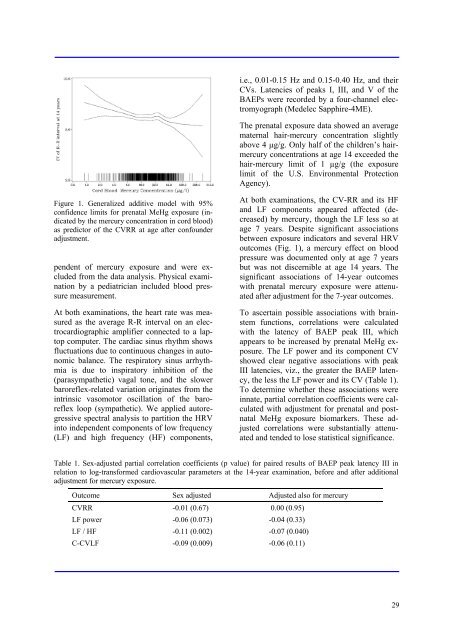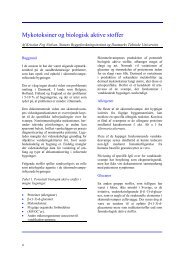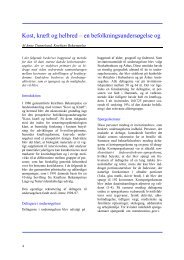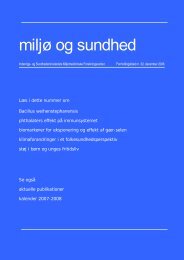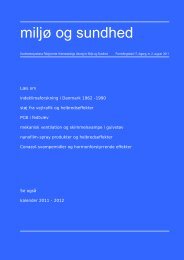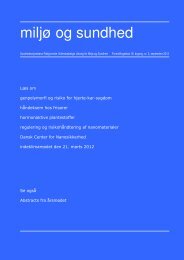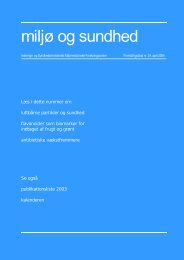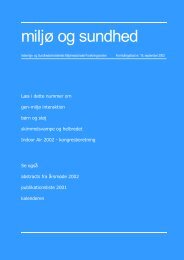Kvartære ammoniumforbindelser - Sundhedsstyrelsens Rådgivende ...
Kvartære ammoniumforbindelser - Sundhedsstyrelsens Rådgivende ...
Kvartære ammoniumforbindelser - Sundhedsstyrelsens Rådgivende ...
You also want an ePaper? Increase the reach of your titles
YUMPU automatically turns print PDFs into web optimized ePapers that Google loves.
i.e., 0.01-0.15 Hz and 0.15-0.40 Hz, and their<br />
CVs. Latencies of peaks I, III, and V of the<br />
BAEPs were recorded by a four-channel electromyograph<br />
(Medelec Sapphire-4ME).<br />
The prenatal exposure data showed an average<br />
maternal hair-mercury concentration slightly<br />
above 4 µg/g. Only half of the children’s hairmercury<br />
concentrations at age 14 exceeded the<br />
hair-mercury limit of 1 µg/g (the exposure<br />
limit of the U.S. Environmental Protection<br />
Agency).<br />
Figure 1. Generalized additive model with 95%<br />
confidence limits for prenatal MeHg exposure (indicated<br />
by the mercury concentration in cord blood)<br />
as predictor of the CVRR at age after confounder<br />
adjustment.<br />
pendent of mercury exposure and were excluded<br />
from the data analysis. Physical examination<br />
by a pediatrician included blood pressure<br />
measurement.<br />
At both examinations, the heart rate was measured<br />
as the average R-R interval on an electrocardiographic<br />
amplifier connected to a laptop<br />
computer. The cardiac sinus rhythm shows<br />
fluctuations due to continuous changes in autonomic<br />
balance. The respiratory sinus arrhythmia<br />
is due to inspiratory inhibition of the<br />
(parasympathetic) vagal tone, and the slower<br />
baroreflex-related variation originates from the<br />
intrinsic vasomotor oscillation of the baroreflex<br />
loop (sympathetic). We applied autoregressive<br />
spectral analysis to partition the HRV<br />
into independent components of low frequency<br />
(LF) and high frequency (HF) components,<br />
At both examinations, the CV-RR and its HF<br />
and LF components appeared affected (decreased)<br />
by mercury, though the LF less so at<br />
age 7 years. Despite significant associations<br />
between exposure indicators and several HRV<br />
outcomes (Fig. 1), a mercury effect on blood<br />
pressure was documented only at age 7 years<br />
but was not discernible at age 14 years. The<br />
significant associations of 14-year outcomes<br />
with prenatal mercury exposure were attenuated<br />
after adjustment for the 7-year outcomes.<br />
To ascertain possible associations with brainstem<br />
functions, correlations were calculated<br />
with the latency of BAEP peak III, which<br />
appears to be increased by prenatal MeHg exposure.<br />
The LF power and its component CV<br />
showed clear negative associations with peak<br />
III latencies, viz., the greater the BAEP latency,<br />
the less the LF power and its CV (Table 1).<br />
To determine whether these associations were<br />
innate, partial correlation coefficients were calculated<br />
with adjustment for prenatal and postnatal<br />
MeHg exposure biomarkers. These adjusted<br />
correlations were substantially attenuated<br />
and tended to lose statistical significance.<br />
Table 1. Sex-adjusted partial correlation coefficients (p value) for paired results of BAEP peak latency III in<br />
relation to log-transformed cardiovascular parameters at the 14-year examination, before and after additional<br />
adjustment for mercury exposure.<br />
Outcome Sex adjusted Adjusted also for mercury<br />
CVRR -0.01 (0.67) 0.00 (0.95)<br />
LF power -0.06 (0.073) -0.04 (0.33)<br />
LF / HF -0.11 (0.002) -0.07 (0.040)<br />
C-CVLF -0.09 (0.009) -0.06 (0.11)<br />
29


